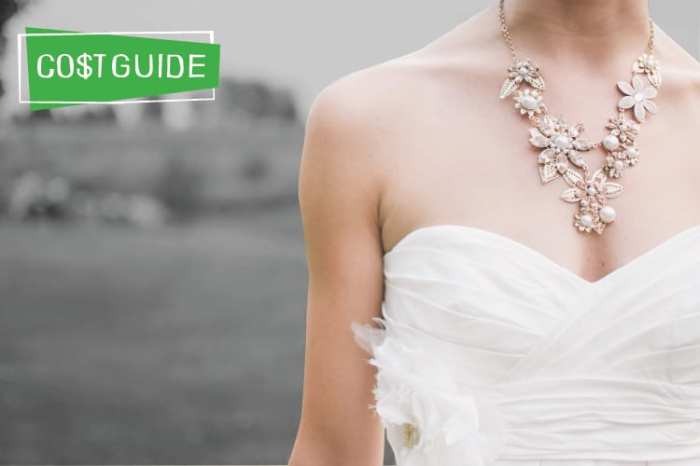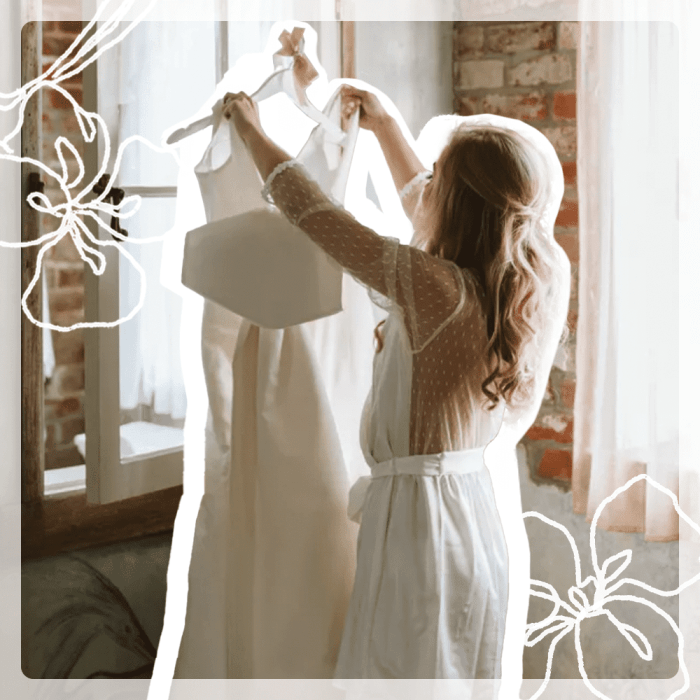Typical Wedding Dress Cost A Comprehensive Guide
Average Wedding Dress Costs
Typical wedding dress cost – The cost of a wedding dress is a significant factor in many brides’ budgets. Prices vary widely depending on several factors, including style, designer, fabric, and embellishments. Understanding these variables is crucial for planning effectively.
Average Wedding Dress Costs by Style
The price of a wedding dress is significantly influenced by its style. Ballgowns, for example, often command higher prices due to the extensive fabric used. Below is a table outlining average price ranges for various styles.
| Style | Price Range (USD) | Common Fabric Types |
|---|---|---|
| A-line | $1,000 – $3,000 | Lace, Satin, Tulle |
| Ballgown | $1,500 – $5,000+ | Silk, Satin, Organza |
| Mermaid | $1,200 – $4,000+ | Lace, Satin, Crepe |
| Sheath | $800 – $2,500 | Silk, Jersey, Crepe |
Wedding Dress Prices by Designer Brand
Designer brands significantly impact the cost of a wedding dress. High-end designers can charge tens of thousands of dollars, while budget-friendly options offer stylish dresses at significantly lower prices.
- High-End: Vera Wang, Galia Lahav (Price Range: $5,000 – $15,000+)
- Mid-Range: Watters, Allure Bridals (Price Range: $1,500 – $4,000)
- Budget-Friendly: BHLDN, David’s Bridal (Price Range: $500 – $1,500)
Factors Influencing Wedding Dress Costs, Typical wedding dress cost

Source: theplunge.com
Numerous factors contribute to the overall cost of a wedding dress. Understanding these factors allows for better budgeting and informed decision-making.
Impact of Fabric Type on Price
The fabric used significantly impacts the price. Luxurious fabrics like silk and intricate lace are more expensive than simpler options like polyester or chiffon. The weight and quality of the fabric also influence the cost.
Embellishments and Dress Price
Embellishments such as beading, embroidery, and appliqués add to the overall cost. Intricate hand-beaded gowns can be significantly more expensive than those with simpler embellishments or no embellishments at all. The level of detail and the type of embellishment influence the price.
Custom-Made vs. Off-the-Rack Dresses
Custom-made dresses typically cost more than off-the-rack options. The added expense covers the design consultation, pattern making, and personalized fittings. Off-the-rack dresses are generally more affordable but may require alterations.
Alterations and Customization Costs

Source: brides.com
Alterations are a common additional expense. The cost varies depending on the extent of the changes needed. Simple hemming might cost a few hundred dollars, while more extensive alterations, like taking in the bodice or adding sleeves, can cost significantly more.
| Alteration Type | Price Range (USD) |
|---|---|
| Hemming | $100 – $300 |
| Bustle Addition | $150 – $400 |
| Significant Bodice Alterations | $300 – $800+ |
Budgeting for a Wedding Dress
Creating a realistic budget is essential for managing wedding expenses. Prioritizing and making informed choices are key to finding the perfect dress without overspending.
Setting a Realistic Wedding Dress Budget
- Determine your overall wedding budget.
- Allocate a percentage for the wedding dress (typically 10-15%).
- Research average dress prices in your preferred style and designer range.
- Set a maximum spending limit and stick to it.
Tips for Finding Affordable Wedding Dresses
Finding a beautiful dress without breaking the bank is achievable with careful planning and resourcefulness.
- Shop during sample sales or trunk shows.
- Consider consignment shops or online marketplaces.
- Explore less expensive designers or brands.
- Borrow a dress from a friend or family member.
Negotiating Prices with Bridal Shops
Negotiating can sometimes lead to savings, especially when purchasing during off-season or sample sales. Be polite and respectful, and present your case clearly.
Exploring Different Dress Styles and Their Costs: Typical Wedding Dress Cost
Wedding dress styles vary widely, each with its unique characteristics and associated price point. Understanding these differences helps in making an informed decision.
Wedding Dress Styles and Price Points

Source: afarose.com
- A-line: Classic and versatile, typically moderately priced.
- Ballgown: Formal and dramatic, usually more expensive due to fabric quantity.
- Sheath: Sleek and form-fitting, often less expensive than ballgowns.
- Empire Waist: Flowing and romantic, generally mid-range in price.
Price Implications of Design Elements
Necklines, sleeve styles, and train lengths all affect the final cost. Intricate necklines and elaborate sleeves can add to the overall expense, as can longer trains requiring more fabric.
Visual Representation of Cost Variations
Imagine a bar graph. The horizontal axis represents different factors influencing dress cost (fabric type, embellishments, designer brand, alterations). The vertical axis represents price. Each bar represents a factor, with its height indicating the price range. For example, a bar representing “silk fabric” would be taller than a bar representing “polyester fabric”.
A bar representing “heavy beading” would be significantly taller than a bar representing “minimal embellishments”.
A simple A-line dress made of chiffon with minimal embellishments would visually appear very different from a heavily embellished ballgown made of silk and lace. The latter would have a much more intricate design and texture, reflecting its higher price point. The difference in fabric weight and the density of embellishments would be visually apparent, immediately communicating the disparity in cost.
The typical wedding dress cost can vary wildly, depending on designer, fabric, and embellishments. A popular choice that often falls within a reasonable price range is a two piece lace wedding dress, such as those found at this online retailer. Ultimately, understanding your budget beforehand is key to finding a gown that fits both your style and your financial plan for the big day.
This helps keep the overall wedding dress cost manageable.
Visually, the difference in fabric types is evident. Silk, for instance, has a luxurious sheen and drape, immediately suggesting higher quality and cost compared to a matte, less flowing fabric like polyester. Lace, with its intricate patterns and texture, visually conveys its higher price point compared to plain satin.
Q&A
Can I negotiate the price of a wedding dress?
Negotiating is possible, especially at smaller boutiques or with independent designers. Be polite, respectful, and prepared to explain your budget constraints.
How long should I start shopping for my wedding dress?
Ideally, start shopping 9-12 months before your wedding to allow ample time for alterations and potential delays.
What is the average cost of alterations?
Alteration costs vary widely depending on the extent of changes needed, but expect to budget an additional 10-20% of the dress price.
Are there ways to find a used wedding dress?
Yes, consider consignment shops, online marketplaces, or borrowing from friends or family. These options can significantly reduce costs.





















